
Original Link: https://www.anandtech.com/show/2012
AMD Socket-AM2: Same Performance, Faster Memory, Lower Power
by Anand Lal Shimpi on May 23, 2006 12:14 PM EST- Posted in
- CPUs
It's taken AMD almost the entire life-span of the Athlon 64, but Intel is finally on the run. Pick whatever measure of success you'd like, whether it is performance benchmarks, the Dell announcement, or being publicly accepted as a threat - AMD has done it. It's because of AMD's extremely successful uphill battle against Intel these past few years that we've had such high expectations from the company. So when Intel first started talking about its new Core architecture, we turned to AMD for a response that it surely must have had in the works for years, but as you all know we came up empty handed.
Only recently has AMD begun talking about what's coming next, and it will divulge even more information in the following weeks. The problem is that the architectural revisions to K8 that AMD is finally talking about now are still things we will see in the 2007 - 2008 time frame, while Intel's Core architecture is still on schedule to be a reality for 2006. What AMD does have planned to keep itself afloat during 2006 and until the new K8L core debuts is a brand new platform: Socket-AM2.
The long awaited Socket-AM2 platform marks the beginning of AMD's transition to DDR2 memory. If you'll remember, Intel made this transition about two years ago with the introduction of its 925X and 915 series of chipsets. The move to DDR2 proved to yield very little in the way of performance, but it was necessary as Intel was able to drive enough quantity of DDR2 in order to make the cost reasonable today. With DDR2 prices low enough, and availability high enough, AMD was poised to take advantage of Intel's work in establishing DDR2 as a desktop memory standard and support it on a new platform.
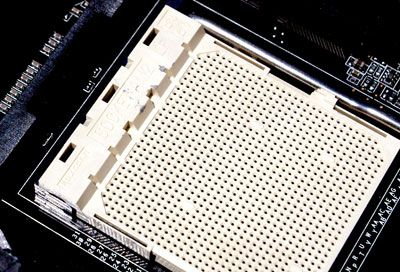
In AMD's uncharacteristic silence over the past several months, performance expectations for DDR2 on Socket-AM2 remained completely unset. A little over a month ago we previewed the Socket-AM2 platform and concluded that even when paired with DDR2-800, you shouldn't expect a performance increase from AM2. While AMD didn't publicly confirm or refute our benchmarks, all of its partners were in agreement with the results we had seen. Today, with final AM2 hardware in our hands, we're able to see exactly how far the platform has come in the month since we last looked at it.
AM2 in Detail
Of course the most prominent feature of AMD's Socket-AM2 platform is the new socket and its support for DDR2 memory. As we've already mentioned, Socket-AM2 is a 940-pin socket that is keyed differently from the original 940-pin Athlon 64/Opteron sockets; only AM2 processors will physically fit into an AM2 motherboard.
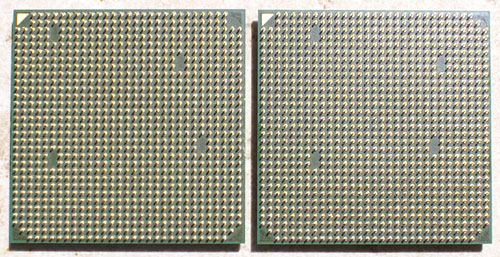
Socket-939 (left) vs. Socket-AM2 (right)
Socket-939 |
Socket-AM2 |
 |
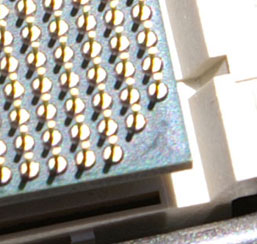 |
One of the Athlon 64's strongest selling points continues to be its on-die memory controller, which has of course been significantly changed for the new Socket-AM2 platform. All AM2 CPUs feature a 128-bit wide DDR2 memory controller, compared to the 128-bit DDR memory controller that we've come to know from the Socket-939 platform. A DDR2 memory interface actually requires more pins than a DDR1 interface, but AMD was able to keep the AM2 pin count down by removing a large number of unnecessary pins on the Athlon 64's package. When the Socket-940/939 Athlon 64s were first designed, approximately 10% of their pins were redundant and could be removed in later designs. Not desiring to introduce a new socket as frequently as its competition had, AMD waited until Socket-AM2 to remove those unnecessary pins thus enabling a dual-channel DDR2 interface in virtually the same pin count as the earlier DDR1 equipped CPUs.
All of the Socket-AM2 CPUs support up to DDR2-667, but the AM2 Athlon 64 X2 and Athlon 64 FX models support up to DDR2-800. Since Socket-AM2 unifies AMD's desktop socket strategy, all Semprons, Athlon 64s, X2s and FX processors will feature this dual channel DDR2 memory controller.

Corsair partnered with AMD and NVIDIA for the Socket-AM2 and nForce 500 review kits
The lineup of Socket-AM2 processors being introduced today are in the table below:
| CPU | Clock Speed | L2 Cache Size | TDP | Price |
| AMD Athlon 64 FX-62 | 2.8GHz | 1MBx2 | 125W | $1031 |
| AMD Athlon 64 X2 5000+ | 2.6GHz | 512KBx2 | 89W | $696 |
| AMD Athlon 64 X2 4800+ | 2.4GHz | 1MBx2 | 89W | $645 |
| AMD Athlon 64 X2 4600+ | 2.4GHz | 512KBx2 | 89W | $558 |
| AMD Athlon 64 X2 4400+ | 2.2GHz | 1MBx2 | 89W | $470 |
| AMD Athlon 64 X2 4200+ | 2.2GHz | 512KBx2 | 89W | $365 |
| AMD Athlon 64 X2 4000+ | 2.0GHz | 1MBx2 | 89W | $328 |
| AMD Athlon 64 X2 3800+ | 2.0GHz | 512KBx2 | 89W | $303 |
| AMD Athlon 64 3800+ | 2.4GHz | 512KB | 62W | $290 |
| AMD Athlon 64 3500+ | 2.2GHz | 512KB | 62W | $189 |
| AMD Sempron 3600+ | 2.0GHz | 256KB | 62W | $123 |
| AMD Sempron 3500+ | 2.0GHz | 128KB | 62W | $109 |
| AMD Sempron 3400+ | 1.8GHz | 256KB | 62W | $97 |
| AMD Sempron 3200+ | 1.8GHz | 128KB | 62W | $87 |
| AMD Sempron 3000+ | 1.6GHz | 256KB | 62W | $77 |
There's basically no price premium for the new Socket-AM2 chips, encouraging a quick transition to AMD's new DDR2 platform.
You will also notice that none of the model numbers have changed, so an Athlon 64 X2 4800+ on Socket-AM2 has the same clock speed and L2 cache size as the Socket-939 version. Since AMD's model numbers haven't changed, you already know not to expect any major changes in performance with Socket-AM2. In fact, the only difference on the CPU side is the introduction of the new Athlon 64 FX-62, Athlon 64 X2 5000+ and Athlon 64 X2 4000+.
Outside of DDR2 support, there are a couple of other features that are introduced with Socket-AM2. The new AM2 CPUs now all support AMD's Virtualization (Pacifica), although we're still fairly short on ways to truly evaluate the performance of both AMD's and Intel's Virtualization support - other than to tell you that it works and can be quite useful when supported by software.
As we've already reported, the Socket-AM2 heatsink retention mechanism has been redesigned potentially requiring new heatsinks depending on the configuration of your old Socket-939 unit. The new heatsink tray is significantly sturdier as it now uses four mounting screws compared to two with the old Socket-939 trays. AMD continues to have a far superior heatsink mount to Intel's from an end-user perspective, as installing a heatsink is as simple as can be on Socket-939 and AM2 compared to the unnecessary complexity of Intel's LGA-775 heatsink mount.
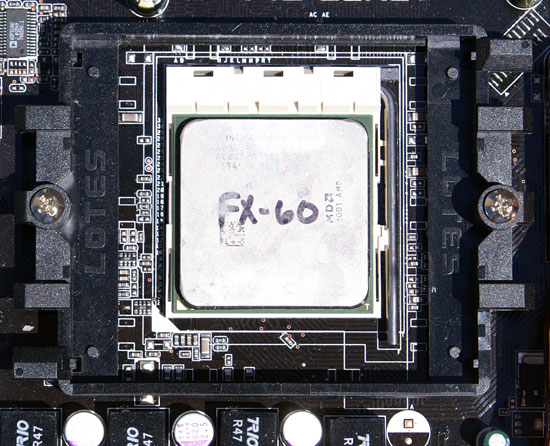
Socket-939

Socket-939
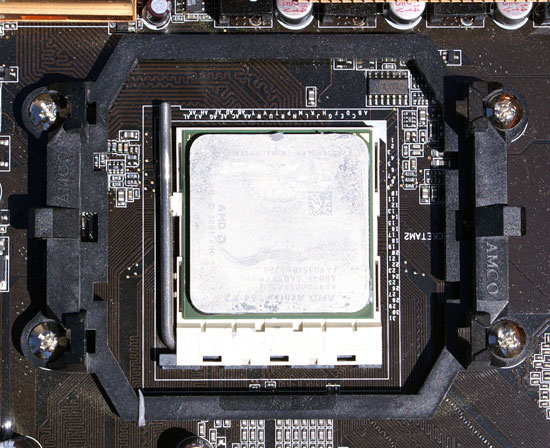
Socket-AM2 (note the four mounting screws)
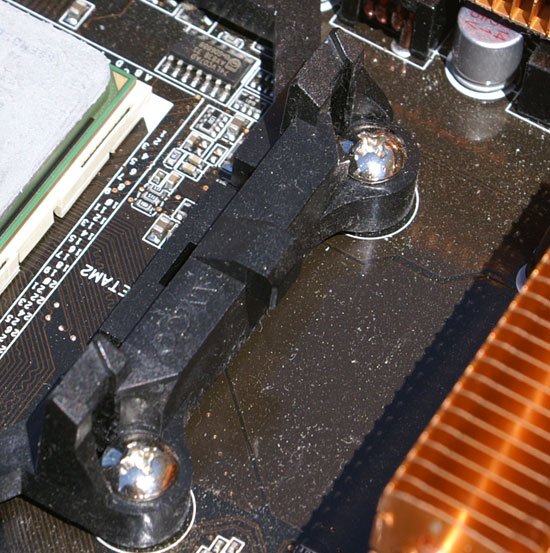
Socket-AM2
Through regular advances in process technology, AMD has also been able to reduce the power consumption of the entire X2 line on Socket-AM2. Now all AM2 X2 parts feature an 89W TDP, whereas previously the higher model number X2s were all 110W parts. AMD confirmed that the lower power consumption would also affect newer fabbed Socket-939 X2s, however AMD will not be changing the TDP ratings on those chips.
On top of reducing power consumption for the Athlon 64 X2 line, Socket-AM2 will also be home to AMD's new Energy Efficient processors. Through the same sort of TDP targeting that is used to manufacture energy efficient Opteron processors, you will now be able to pay a premium and purchase cooler running Athlon 64, X2 and Sempron AM2 processors. The clock speeds and model numbers remain the same, but these new processors will either carry an Energy Efficient logo indicating a 65W TDP or an Energy Efficient Small Form Factor logo that indicates a 35W TDP.
The entire list of Energy Efficient and EE SFF CPUs is listed below:
| CPU | TDP | Price | Premium |
| AMD Athlon 64 X2 4800+ Energy Efficient | 65W | $671 | +$26 |
| AMD Athlon 64 X2 4600+ Energy Efficient | 65W | $601 | +$43 |
| AMD Athlon 64 X2 4400+ Energy Efficient | 65W | $514 | +$44 |
| AMD Athlon 64 X2 4200+ Energy Efficient | 65W | $417 | +$52 |
| AMD Athlon 64 X2 4000+ Energy Efficient | 65W | $353 | +$25 |
| AMD Athlon 64 X2 3800+ Energy Efficient | 65W | $323 | +$20 |
| AMD Athlon 64 X2 3800+ Energy Efficient Small Form Factor | 35W | $364 | +$61 |
| AMD Athlon 64 3500+ Energy Efficient Small Form Factor | 35W | $231 | +$42 |
| AMD Sempron 3400+ Energy Efficient Small Form Factor | 35W | $145 | +$48 |
| AMD Sempron 3200+ Energy Efficient Small Form Factor | 35W | $119 | +$32 |
| AMD Sempron 3000+ Energy Efficient Small Form Factor | 35W | $101 | +$24 |
For anywhere from $20 - $60 over their 89W and 62W counterparts, you can now have 65W or 35W Energy Efficient AM2 CPUs. The price premium is tacked onto the processors because these lower wattage parts don't yield at the same rate as the higher wattage CPUs, and thus require a higher price to make up for the decrease in yield. But honestly, the premium on a lot of the CPUs is small enough that we can't help but recommend them (assuming the real world reduction in power is in line with AMD's reduction in TDP rating).
The Energy Efficient Small Form Factor Athlon 64 X2 3800+ at a mere 35W (less than half the TDP of the standard X2 3800+) is particularly interesting to us, but unfortunately we'll have to wait before being able to provide you all with power measurements. While all regular AM2 CPUs are available beginning today, the new Energy Efficient models won't be available in the channel until sometime in June. AMD did not have enough samples on hand to even provide us with one in time for publication, citing extreme OEM demand as the reason for supply being so tight. Hopefully when these CPUs do hit the channel we won't see any sort of price gouging as they are extremely attractive.
There are of course a long list of of new motherboards and chipsets with support for Socket-AM2, but we'll save the deep dive on both of those topics for some of our other articles in the works. Later today you'll be able to read all about NVIDIA's new nForce 500 platform, later in the week you'll see what ATI has to offer for AM2 and then next week we'll have our first roundup of Socket-AM2 motherboards.
The Test
| CPU: | AMD Athlon 64 FX-62 (Socket-AM2) AMD Athlon 64 FX-60 (Socket-939) AMD Athlon 64 X2 5000+ (Socket-AM2) AMD Athlon 64 X2 4000+ (Socket-AM2) AMD Athlon 64 X2 3800+ (Socket-AM2) Intel Pentium Extreme Edition 965 Intel Pentium D 960 Intel Pentium D 950 |
| Motherboard: | ASUS A8N32-SLI (Socket-939) ASUS M2N32-SLI (Socket-AM2) Intel D975XBX |
| Chipset: | NVIDIA nForce4 SLI x16 NVIDIA nForce 590 SLI |
| Chipset Drivers: | nForce 9.34 Beta |
| Hard Disk: | Seagate 7200.9 300GB SATA |
| Memory: | Corsair XMS2 DDR2-800 4-4-4-12 (1GB x 2) OCZ DDR-400 2-2-2 (1GB x 2) |
| Video Card: | NVIDIA GeForce 7900 GTX |
| Video Drivers: | NVIDIA ForceWare 91.27 Beta |
| Desktop Resolution: | 1280 x 1024 - 32-bit @ 60Hz |
| OS: | Windows XP Professional SP2 |
The Question on Everyone's Mind: Is AM2 Faster?
We've structured this CPU review a little different than in our past, organizing the content into answers to a series of questions that we had about Socket-AM2 and the performance of the platform. The first question on everyone's mind is, of course, is Socket-AM2 any faster than Socket-939. When we previewed AM2 we concluded that no, it wasn't, however we were using pre-release hardware and it was possible that the performance had changed since then. But the following statement from AMD pretty much confirmed exactly what we expected:
"A fair expectation for performance gain from 939-pin to AM2 is about 1% or more across various application-based benchmarks. That assumes equal model numbers for processors and an equal configuration. This also assumes premium memory is used for each configuration."
With AMD telling us that we should expect about a 1% increase in performance, it doesn't look like Socket-AM2 will have much to offer in the way of performance. Of course we needed to confirm for ourselves, and the table below shows just that:
| Benchmark - Athlon 64 X2 4800+ | Socket-939 (DDR-400) | Socket-AM2 (DDR2-800) | % Advantage (Socket-AM2) |
| Cinebench 9.5 Multi-Core Rendering Test | 660 | 658 | 0% |
| 3dsmax 7 | 2.79 | 2.78 | 0% |
| Adobe Photoshop CS2 | 183.2 s | 180.2 s | +1.6% |
| DivX 6.1 | 54 fps | 54 fps | 0% |
| WME9 | 42.2 fps | 42.7 fps | +1.2% |
| Quicktime 7.0.4 (H.264) | 3.12 min | 3.10 min | +0.1% |
| iTunes 6.0.1.4 (MP3) | 35 s | 35 s | 0% |
| Quake 4 - 10x7 (SMP) | 133.1 fps | 138.6 fps | +4.0% |
| Oblivion - 10x7 | 56.1 fps | 58.0 fps | +3.3% |
| F.E.A.R. - 10x7 | 114 fps | 116 fps | +1.8% |
| ScienceMark 2.0 (Bandwidth) | 5397 MB/s | 6844 MB/s | +27% |
| ScienceMark 2.0 (Latency 512-byte stride) | 47.3 ns | 42.72 ns | +9.7% |
The numbers we're seeing here today for Socket-939 vs. Socket-AM2 are virtually identical to what we saw last month in our preview. Socket-AM2 doesn't appear to offer any tangible improvement in performance except for within certain games and of course in the memory bandwidth and latency tests. Thankfully, on final hardware, we're at least not seeing any drop in performance.
The good news is that if you've just invested in a new Socket-939 platform, you're not leaving any performance behind by not having an AM2 system. The bad news is that, for AMD, the only performance increases this launch will bring are because of the speed bumps of the Athlon 64 FX-62 and the X2 5000+.
Does AM2 Reduce the Impact of L2 Cache Size?
We've already seen that Socket-AM2 doesn't really impact performance except for in games, but does the higher bandwidth memory controller reduce the impact of AMD's 1MB L2 cache parts compared to its 512KB L2 cache offerings?
| Benchmark - Athlon 64 X2 2.0GHz | Socket-939 (1MB vs. 512KB Advantage) | Socket-AM2 (1MB vs. 512KB Advantage) |
| Cinebench 9.5 Multi-Core Rendering Test | 0.2% | 0% |
| 3dsmax 7 | 0.3% | 0.6% |
| Adobe Photoshop CS2 | 2.7% | 2.5% |
| DivX 6.1 | 0% | 0% |
| WME9 | 0% | 1% |
| Quicktime 7.0.4 (H.264) | 0.9% | 1.3% |
| iTunes 6.0.1.4 (MP3) | 0% | 0% |
| Quake 4 - 10x7 (SMP) | 4.8% | 3.5% |
| Oblivion - 10x7 | 7.5% | 3.3% |
| F.E.A.R. - 10x7 | 8.6% | 6.2% |
In the application benchmarks there isn't really a difference in how performance scales with cache size between the two platforms, but looking at the games there is indication of a pattern that is developing.
In Quake 4, Oblivion and F.E.A.R. the 1MB L2 cache seems to make slightly more of a difference on the Socket-939 platform than on the Socket-AM2 platform. While the 1MB cache offers a 4.8%, 7.5% and 8.6% performance advantage in those three games on the Socket-939 platform, on AM2 the advantage is cut down to 3.5%, 3.3% and 6.2% respectively. The explanation being that with a lower latency memory controller and more available memory bandwidth, the benefits of a larger cache are reduced on Socket-AM2.
However the differences in performance scaling that we're seeing here are small enough that once you take into account the amount of variation you can see between runs, it's not really worth concluding anything concrete based on this data. What we do see here is a trend of the 1MB L2 cache parts doing less on Socket-AM2 than on Socket-939 (another way of looking at it is that the 512KB are doing better on AM2 than they did on 939), but the margins are small enough that we can't really say for sure what is causing the trend.
Once again, the trend only seems to impact games, as the other application tests we've run appear to be basically unaffected.
How Does the New 4000+ Stack Up?
Today AMD is also introducing a new X2, the Athlon 64 X2 4000+. Running at 2.0GHz but equipped with a 1MB L2 cache, the X2 4000+ fits nicely in between the X2 3800+ and the X2 4200+. Its pricing is also in between the two chips, coming in at $25 more than a X2 3800+ and $37 less than the X2 4200+.
The closest competition from Intel, after its recent price cuts, is the Pentium D 950. Clocked at 3.4GHz and armed with a 2MB L2 cache per core, the Pentium D 950 is priced at $316 in 1,000 unit quantities putting it in between the X2 4000+'s $328 and the X2 3800+'s $303 price tag.
3D Rendering - Cinebench 9.5
Our first benchmark is a 3D rendering test using Cinebench 9.5. We focused on the multi-threaded CPU rendering scores since we're primarily testing dual-core CPUs here. The benchmark reports performance in its own Cinebench units, but the important thing is that higher numbers mean better performance.

Cinebench 9.5 shows absolutely no performance difference between the 3800+ and the 4000+, indicating that the 512KB of L2 cache per core is sufficient for the dataset used in this test (alternatively it could be that even a 1MB L2 cache isn't big enough to hold the working dataset). The end result is that since the 3800+ and the 4000+ feature the same clock speed, in situations where a larger L2 cache isn't helpful we'll see absolutely no performance difference between the two processors. Combine this with the possibility that 512KB parts perform better on AM2 than they did on 939 and we start off seeing very little need to recommend the 4000+ over the cheaper 3800+.
3D Rendering - 3dsmax 7
Our next 3D rendering test has been around for a while on AnandTech, it's the 3dsmax 7 SPECapc test that we've used in past CPU reviews. The results we're reporting here are the SPECapc composite scores which are a geometric mean of four rendering tests and scaled against a set of reference scores that are included with the SPECapc benchmark package.

Once again we see basically no performance difference between the 3800+ and the 4000+, proving that clock speed is all that matters here with the Athlon 64 X2. Unlike the Cinebench test however, the Pentium D 950 is able to take the performance lead. Intel's Pentium D architecture continues to be quite competitive in 3D rendering and media encoding tasks as we're about to see.
Video Encoding - DivX 6.1.1 Pro
Next up to bat is DivX 6.1.1 Pro, once again a benchmark used in previous CPU reviews. Our testing methodologies haven't changed, so let's take a look at the results.
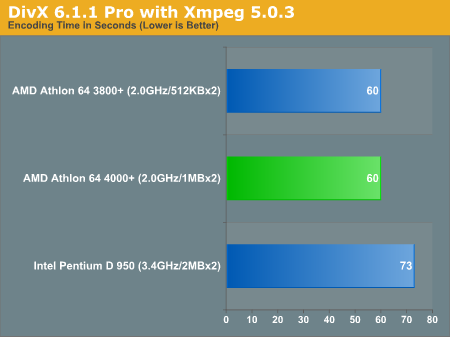
DivX performance is extremely strong with the Athlon 64 X2 4000+ and 3800+, but once again we see absolutely no performance difference between the two CPUs. Both AMD offerings are able to significantly outperform the Pentium D 950.
Video Encoding - Windows Media Encoder 9
While H.264 is the way of the future for video encoding, the vast majority of content today is still encoded in MPEG-2, DivX or using Microsoft's Windows Media Encoder codecs. Just as in previous reviews we're using the Advanced Profile enabled by installing Media Player 10 alongside WME9 which allows for better video quality options and as a result ends up stressing dual-core CPUs even more.
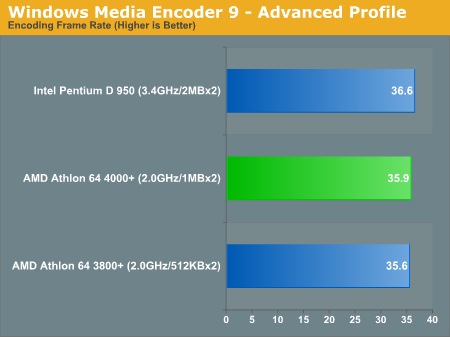
The Athlon 64 X2 4000+ manages to pull slightly ahead of the 3800+, but the two are basically tied. The Pentium D 950 is far more competitive in the WME9 test but isn't tangibly faster than the X2 4000+.
Video Encoding - Quicktime Pro 7.0.4 (H.264)
Until we get support for GPU accelerated H.264 encoding and/or faster CPUs, the number of H.264 encoding applications will remain quite limited. Apple's Quicktime Movie Trailers site has a great deal of H.264 encoded content and using Quicktime 7.0.4 you can generate the same quality, bitrate and file size of content. This is the same test we've run in the past, re-encoding the SD Quicktime movie trailer for Hoodwinked using the H.264 codec. All of the encoding settings were left at their defaults.
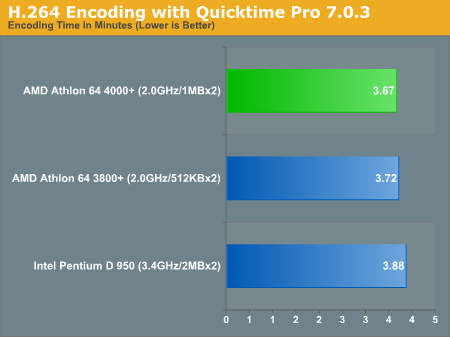
We continue to see a very small performance advantage for the Athlon 64 X2 4000+ but it's nothing worth writing home about, the X2 3800+ is just as good. The Pentium D 950 continues to be a close competitor but definitely isn't any faster than the two AMD solutions.
MP3 Encoding - iTunes 6.0.1.4
Almost a decade ago MP3 playback and encoding could bring even the fastest system to its knees, but today we can encode a 300MB wav into a 192 kbps MP3 in far less than a minute. We left all settings on their defaults except that we did not allow iTunes to play back the song while importing.
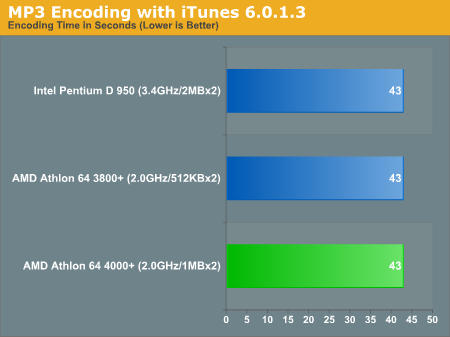
Given the nature of MP3 encoding it's not a surprise that there's no performance difference between the 4000+ and 3800+, but there's also no difference in performance between the AMD solutions and the Pentium D 950.
Gaming - Quake 4 1.1
With the later versions of Quake 4, id Software implemented multi-core support and we saw some pretty impressive performance gains on dual-core CPUs. As always we ran at the game's built in High Quality settings at a resolution of 1024 x 768; SMP was of course enabled.
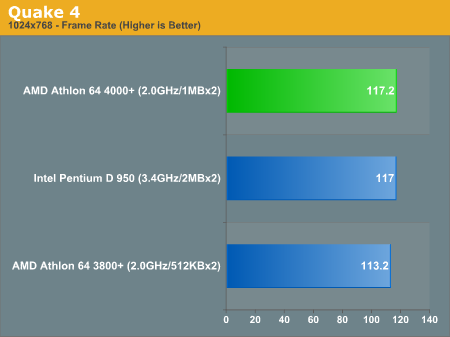
Just as we saw performance differences between AM2 and 939 in games, we see a difference between the 4000+ and 3800+ in these very same games. The fact that the AM2 platform sees a performance gain in 3D games indicates that they are noticeably more memory bandwidth dependent than other applications, and thus we see a benefit to the 4000+'s larger L2 cache. The Pentium D 950 does surprisingly well here, especially considering Intel's very poor reputation for gaming performance.
Gaming - F.E.A.R.
With the graphics options set to F.E.A.R.'s default High Quality and the computer settings at Maximum, we ran the built in F.E.A.R. benchmark reporting average frame rate.
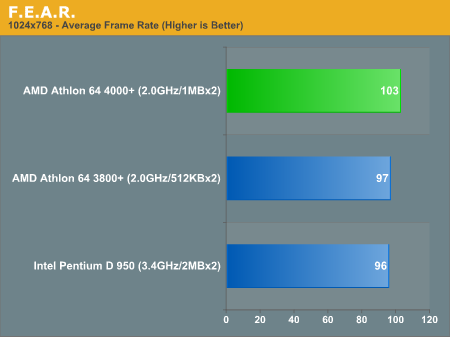
The Athlon 64 X2 4000+ holds a 6% performance advantage over the 3800+ thanks to its larger L2 cache, which continues to make a reasonable difference in our gaming tests. The Pentium D 950 is nipping at the heels of the 3800+, but the 4000+ is untouched at the top here.
Gaming - Oblivion
Our final gaming benchmark uses Oblivion at the same quality settings we used in our recent Oblivion CPU comparison, the only difference is that we ran at 1024 x 768 to make this more of a CPU test and less of a GPU test. We used our Oblivion Town benchmark and reported the average frame rate obtained using FRAPS.
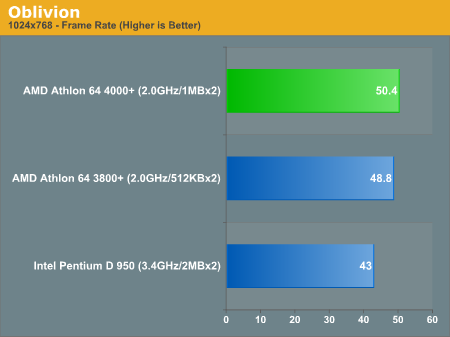
As we saw in our Oblivion CPU comparison, this game really favors AMD's K8 architecture for all of its strengths and severely penalizes the Pentium D for its NetBurst roots. The Athlon 64 X2 4000+ does continue to hold a performance advantage over the 3800+, but it isn't as large in Oblivion as we've seen in the previous two games.
So How Does the Athlon 64 X2 4000+ Stack Up?
At the end of the day the Athlon 64 X2 4000+ is still a very nice CPU that doesn't cost that much more than an X2 3800+; however, unless you're a gamer, you can probably get by pocketing the difference and sticking with the extremely competent 3800+. This is one of the unfortunate consequences of AMD's model number system, where a model number increase can be attributed to either a clock speed bump or an increase in cache size - the model number won't always convey true performance.
Surprisingly enough, the Pentium D 950 is extremely competitive here. Since it's built on Intel's new 65nm process the CPU is actually fairly cool compared to Pentium Ds of the past. Competition is good, but with sometimes significantly higher gaming performance, the Athlon 64 X2 still gets our recommendation here.
A New FX
The next new CPU introduction that we're here to evaluate is the Athlon 64 FX-62, a 2.8GHz dual-core FX part that's debuting exclusively on the Socket-AM2 platform. Given AMD's policy of only having one active FX part at a time (prior violations of this rule aside), the FX-62 is the only FX on the AM2 platform. The FX-60 still reigns supreme on the Socket-939 platform, and since the two platforms perform the same we can pretty much compare the FX-60 to the FX-62 directly without worrying about any motherboard/memory/chipset differences skewing the comparison. Of course no very-high-end CPU comparison is complete without Intel's latest Extreme Edition processor, which in this case is the Pentium Extreme Edition 965 we reviewed back in March.
3D Rendering - Cinebench 9.5
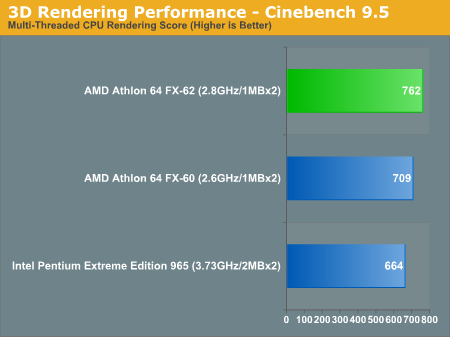
The beauty of the FX series of AMD processors is that its cache size doesn't vary like the rest of the Athlon 64 line, so the FX-62 has an undeniable performance advantage thanks to its 2.8GHz clock speed. The clock speed advantage is able to give it a pretty decent performance boost over the FX-60 here, as well as over the Pentium EE 965.
3D Rendering - 3dsmax 7
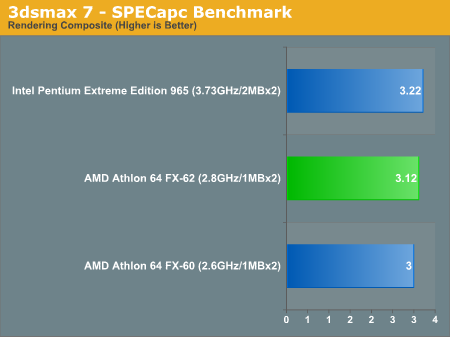
While we see a performance increase over the FX-60 in 3dsmax 7, it isn't enough to catch up to the performance of the Pentium EE 965. At 3.73GHz, the 965 is an extremely formidable competitor and very high performance CPU for 3dsmax rendering tasks.
Video Encoding - DivX 6.1.1 Pro

Intel gets the slight nod in DivX encoding performance, with the FX-62 falling smack in the middle of the chart here between the 965 and the FX-60.
Video Encoding - Windows Media Encoder 9
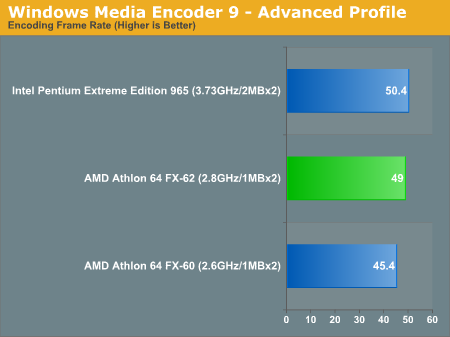
The situation doesn't really change with WME9; the FX-62 manages to come very close to the Extreme Edition 965's performance but falls a little short. The improvement over the FX-60 is quite noticeable here.
Video Encoding - Quicktime 7.0.4 (H.264)
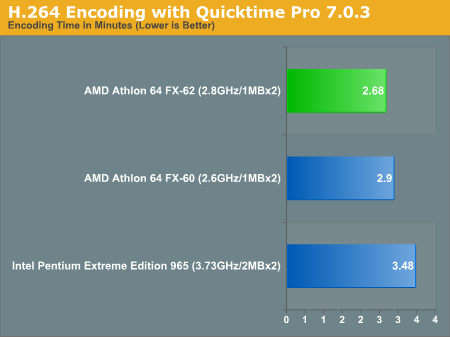
Apple's Quicktime for Windows has never run well on Intel processors, and the FX-62 takes good advantage of that fact by putting the Extreme Edition 965 to shame in our H.264 encoding test. After looking at the 4000+ vs. 3800+ comparison on the previous page, it's nice to see a real tangible performance difference between two AMD CPUs.
MP3 Encoding - iTunes 6.0.1.4
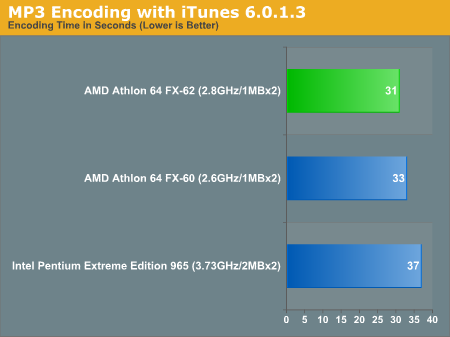
While all three CPUs are very competitive in their MP3 encoding performance the Athlon 64 FX-62 is the clear winner here, finishing the encoding task 16% faster than the Pentium EE 965.
Gaming - Quake 4
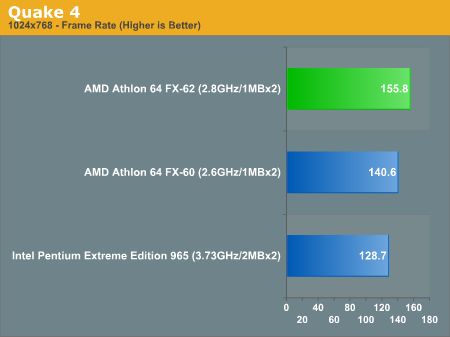
At higher clock speeds the Athlon 64 FX-62 really separates itself from the Pentium EE 965, offering a very significant 21% performance advantage in Quake 4.
Gaming - F.E.A.R.
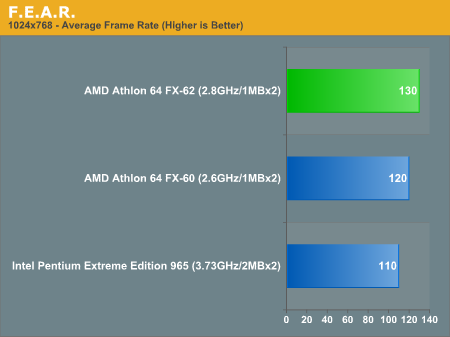
The AMD gaming advantage continues in F.E.A.R., this time the FX-62 holds on to a solid 18% lead.
Gaming - Oblivion
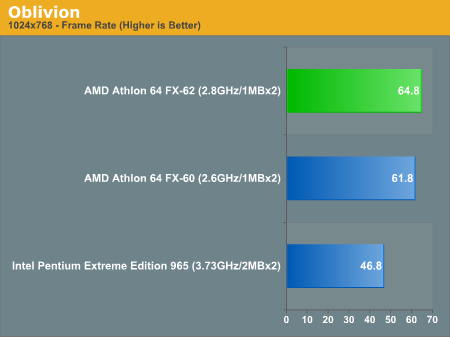
The Pentium Extreme Edition 965 is utterly disappointing in Oblivion, as the FX-62 outperforms it by an incredible 38%. With a very CPU and GPU dependent game like Oblivion, you can't ignore these types of performance differences, especially if you plan on feeding a pair of high end GPUs in SLI or CrossFire.
Athlon 64 FX-62 Conclusion
The Athlon 64 FX-62 verdict is a lot easier than with the 4000+ since the performance advantage is clear thanks to a 1MB L2 cache per core and an increase in clock speed. We would still recommend the FX-62 over the Extreme Edition 965 for gamers, but as we've seen in the past there are some situations where being able to execute four simultaneous threads, as you can with the EE, has its benefits.
Given the incredible price premium you pay for the FX-62, we would still strongly recommend going with a lower clocked Athlon 64 X2 instead. You can always overclock to get close to FX-62 performance or, alternatively, you could stay at the lower clock speed and enjoy lower thermal output.
Athlon 64 X2 5000+: A Cheap FX or Overpriced 4800+?
Although the FX-62 conclusion was pretty straight forward, the Athlon 64 X2 5000+ gives us another ambiguous candidate to evaluate. Clocked at 2.6GHz, the 5000+ gives you a nice clock speed advantage over previous X2s. However, with only a 512KB L2 cache there may be situations where the clock speed advantage over the Athlon 64 X2 4800+ is diminished.
3D Rendering - Cinebench 9.5
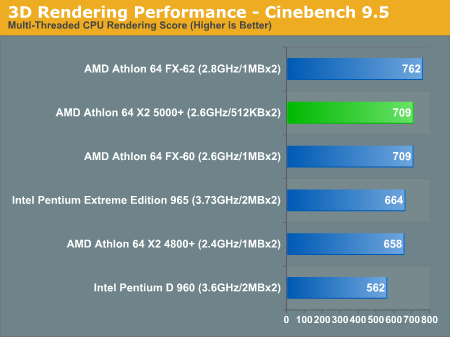
We've already seen that many of our 3D rendering and media encoding tests are cache-size independent when running on Athlon 64 X2/FX processors, thus it's no surprise that the X2 5000+ is able to offer identical performance to the FX-60 despite having half the L2 cache per core. The clock speed advantage over the X2 4800+ is also significant enough to offer a pretty decent performance advantage; in fact, in this light, the Athlon 64 X2 5000+ looks pretty impressive.
3D Rendering - 3dsmax 7
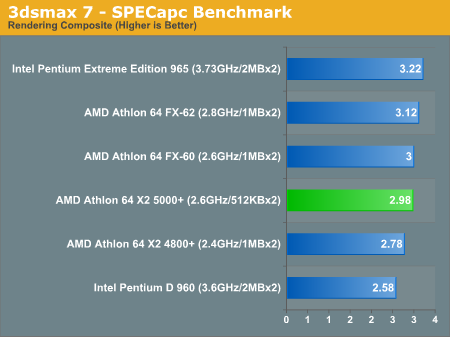
The story under 3dsmax 7 is pretty similar to what we saw under Cinebench; there is a slight performance penalty compared to the FX-60 thanks to a smaller L2 cache, but overall the performance of the X2 5000+ is quite respectable. As we saw in our FX-62 investigation from the previous page, the Extreme Edition 965 is very tough to beat in this test thanks to its high clock speed, very fast FSB and dual core + Hyper Threading combination.
Video Encoding - DivX 6.1.1 Pro
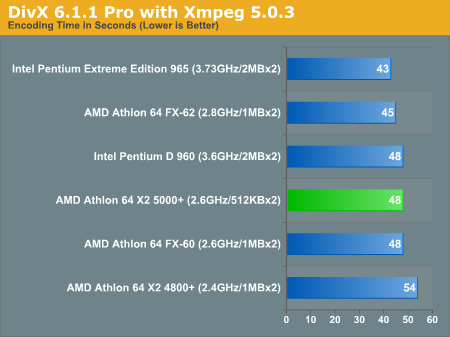
Once again, there's no performance difference between the X2 5000+ and the FX-60, bringing the 5000+ very close in performance to the FX-62 at a significantly lower cost. Thanks to the clock speed advantage, the 5000+ is also clearly faster than the X2 4800+.
Video Encoding - Windows Media Encoder 9
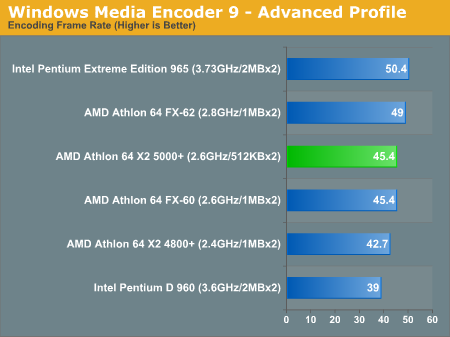
Windows Media Encoder 9 also has the X2 5000+ and FX-60 performing identically, and obviously outperforming the X2 4800+.
Video Encoding - Quicktime 7.0.4 (H.264)
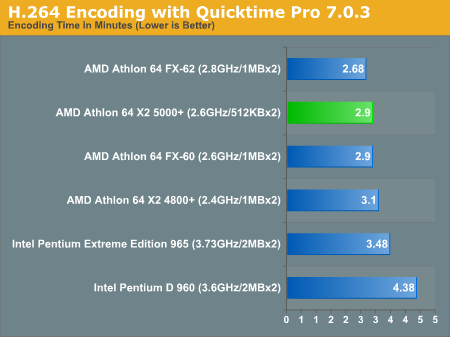
The video encoding trend continues with our Quicktime H.264 test, the 5000+ is second only to the FX-62.
MP3 Encoding - iTunes 6.0.1.4
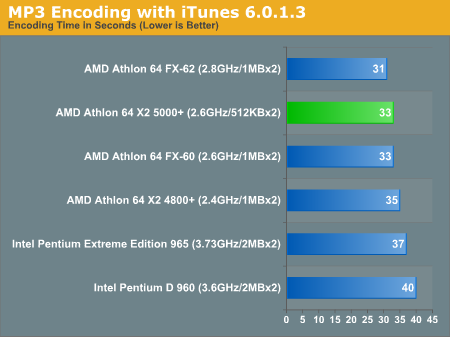
Our iTunes MP3 encoding test produces identical results to what we've already seen in previous benchmarks, the Athlon 64 X2 5000+ isn't really hampered by its 512KB L2 cache thus far.
Gaming - Quake 4
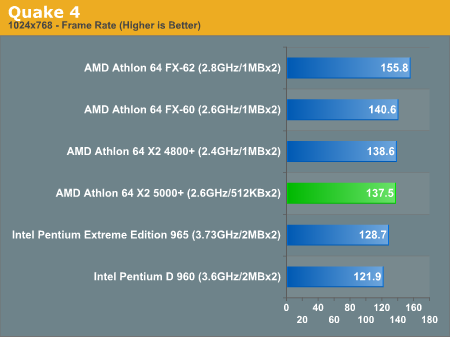
The tables do turn as we look at gaming performance however; not only does the Athlon 64 X2 5000+ lose to the FX-60, but it also loses to the lower clocked Athlon 64 X2 4800+. While the Athlon 64 X2 5000+ is wonderful in our application tests, it looks like there may be a very different verdict for gamers.
Gaming - F.E.A.R.

Under F.E.A.R. the FX-60 is faster than the X2 5000+ once again, but this time the best the X2 4800+ can manage is to tie the performance of the 5000+. Given the $51 price premium for the 5000+, we'd want something that was at least faster than the 4800+.
Gaming - Oblivion
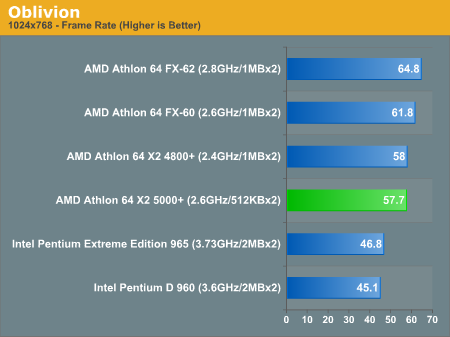
Finally in Oblivion we see that the X2 4800+ is ever so slightly faster than the 5000+, once again thanks to its larger L2 cache (despite a lower core clock speed).
The Athlon 64 X2 5000+ Conclusion
Once again we see the problem with AMD's model number system, where in some cases the 5000+ is no different than a FX-60 and in others it is only as fast if not slower than the cheaper X2 4800+. Our recommendation here would be to only opt for the 5000+ if you aren't a gamer, as it seems that 3D games are far more likely to appreciate a larger L2 cache than a higher clock speed with these chips.
The Odd Multiplier Issue
Another item that was working against the Athlon 64 X2 5000+ on the previous page was the fact that it used an odd clock multiplier, in this case 13.0, in order to achieve its 2.6GHz clock speed. The problem with odd clock multipliers on AM2 CPUs is that the memory controller actually runs at DDR2-742 instead of DDR2-800. AM2 CPUs with even clock multipliers can run at DDR2-800 without any problems, and the reason why is pretty simple.
Below is the equation for calculating the memory speed of any Athlon 64 processor:
Reference Clock * Clock Multiplier = CPU Frequency
CPU Frequency / Memory Divisor = Memory Frequency
AMD only supports integer memory divisors, but let's start out by looking at how an AM2 CPU with an even clock multiplier fits the equation. For example, an Athlon 64 X2 4800+ runs at 2.4GHz and supports DDR2-800.
200MHz Reference Clock * 12x Clock Multiplier = 2400MHz CPU Frequency
2400MHz CPU Frequency / 6 = 400MHz DDR2-800 Memory Frequency
No problems, right? Now let's see how an odd clock multiplier changes things:
200MHz Reference Clock * 13x Clock Muliplier = 2600MHz CPU Frequency
2600MHz CPU Frequency / 6 = 433MHz DDR2-866 Memory Frequency
2600MHz CPU Frequency / 7 = 371MHz DDR2-742 Memory Frequency
See a problem? Because we can only use integer memory dividers, the only options for memory speed on a CPU with an odd clock multiplier are DDR2-866 or DDR2-742. Since AMD can't run above DDR2-800 spec, the only option is to underclock the memory to DDR2-742. This wasn't a problem on Socket-939 CPUs because DDR-400 ran at a 200MHz frequency, which you could always obtain by dividing the CPU clock frequency by an integer (since AMD never supported half multipliers). In fact, you simply used the same integer as the CPU multiplier. With DDR2-800, you need a 400MHz clock frequency, which you can only generate if you have an even CPU clock multiplier.
The problem gets even more complicated when you take into account the fact that Semprons and single-core Athlon 64s only support DDR2-667, which also has a similar issue.
While we haven't seen any significant downside to only running at DDR2-742 vs. DDR2-800, it is something to keep in mind when deciding what CPU to purchase. If you want your memory controller running at DDR2-800, you may want to stay away from the odd clock multiplier CPUs (X2 5000+, 4400+ and 4200+).
Power Consumption
Given that AMD reduced power consumption a bit alongside the move to Socket-AM2, we wanted to see how the new chips compared to the latest CPUs AMD had sent us prior to the launch. So we pitted our last Socket-939 sample, the Athlon 64 FX-60, against the two new Socket-AM2 samples we just received: the Athlon 64 FX-62 and the X2 5000+. Remember that the FX-62 actually carries a 125W TDP rating, so it shouldn't be any cooler than previous CPUs, but the X2 5000+ is a new 89W part.
There are inevitably going to be power differences between the Socket-AM2 and Socket-939 motherboards we used, but unfortunately there was no way to isolate them from the comparison as we are measuring total system power consumption.

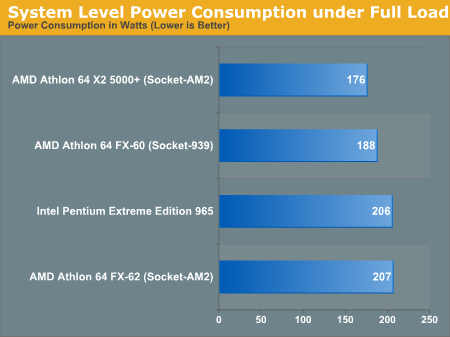
Under full load, the X2 5000+ does appear to be a bit cooler than the Socket-939 FX-60. We've seen in the past that the 1MB vs. 512KB of cache doesn't really result in any significant difference in power consumption, so it looks like the overall decrease in power consumption is because of the improvements in production AMD has implemented at Fab 30. It is worth noting that the Pentium Extreme Edition 965 consumes just as much power as the FX-62, thanks to its 65nm manufacturing process. Even so, we still can't wait for Intel to drive its power consumption levels even lower later this year.
Final Words
And there you have it, quite possibly the most unimpressive launch from AMD (from a performance perspective), but given what we had already seen prior to today there shouldn't be any surprises. The introduction of the Athlon 64 FX-62 means that there is an even faster alternative for those looking to spend as much as possible on a desktop or workstation CPU, but the new 5000+ isn't really all that appealing, especially if you're a gamer.
Socket-AM2 is unfortunately not about performance, and much about bringing a unified memory platform not only to AMD but to the industry as a whole. With all desktop AMD CPUs sharing a single socket end users and OEMs alike will have a much easier job when building AMD systems. On a much more macro scale, with both AMD and Intel using DDR2 memory prices should be driven down even further and switching between platforms will no longer require throwing away your entire memory investment.
The big story with Socket-AM2 is really the introduction of the new Energy Efficient and Energy Efficient Small Form Factor CPUs, but unfortunately those are not yet available. Instead, today's launch ends up being much more about the chipsets being used on AM2 motherboards rather than the CPUs. Later today we will be looking at NVIDIA's nForce 500 series and how the evolution of the most popular AMD chipset has taken to the Socket-AM2 platform.
It is ironic and equally unfortunate for AMD that on the eve of Intel finally getting its act together, that the Socket-AM2 launch is so devoid of any sort of performance improvements. It's clear that AMD's architecture just simply isn't starved of memory bandwidth at this point, and it will take either higher clock speeds or architectural improvements to make the move to DDR2 necessary. We are happy with the fact that AMD at least kept memory latency down while moving to DDR2, but at this point there's simply no use for the bandwidth.
In the coming months we will see the official launch of Intel's Core 2 Duo processors, based on the Conroe core. Only time will tell how availability will affect pricing of those CPUs, but Intel is quite eager to release them. AMD is also awaiting the launch of Core 2 Duo, though for different reasons; in fact one of its stipulations for sending out Socket-AM2 review kits was that the CPUs not be compared to Conroe. We understood and agreed with AMD's stance on the issue, simply because Core 2 Duo (Conroe) isn't shipping yet while AM2 is, but we do get a sense of concern whenever Conroe is brought up around AMD.
AMD does have one last trick up its sleeve before the end of the year, and you will hear about it in June. It's not K8L and it's not going to affect the majority of people, but it is an interesting stop gap solution for the high end in 2006...







